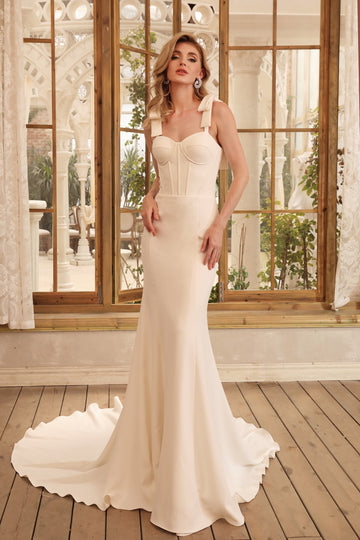Mastering Modern Bridal Gown Alterations: A Comprehensive Guide
Mastering Modern Bridal Gown Alterations: A Comprehensive Guide
The Importance of Modern Bridal Gown Alterations
When it comes to weddings, every detail counts, and one of the most significant aspects is the bridal gown. A modern bridal gown embodies elegance and style, but it's essential to ensure that it fits the bride perfectly. Alterations can transform a beautiful gown into a stunning masterpiece that highlights the bride’s unique figure and style. This guide will explore everything you need to know about modern bridal gown alterations, including tips, common practices, and FAQs.
Why Are Alterations Necessary?
Even the most exquisite gowns may require alterations to achieve that perfect look. Here are a few reasons why alterations are necessary:
- Personal Fit: Every bride has a unique body shape, and even standard sizes may not correspond perfectly with their measurements.
- Style Preference: Brides may want to modify their gowns to better reflect their personal style, such as changing the neckline or hemline.
- Comfort: Ensuring the gown is comfortable for movement and dancing is crucial for enjoying the wedding day.
- Modern Trends: The fashion world continually evolves, and brides may wish to incorporate the latest trends into their dress.
Common Types of Alterations Experienced by Brides
| Type of Alteration | Description |
| Hem Adjustments | Shortening or lengthening the gown to ensure it hits the right place with brides' footwear. |
| Waist and Bust Adjustments | Taking in or letting out seams for a snug fit around the waist and bust. |
| Sleeve Modifications | Adding, removing, or changing the style of sleeves according to the bride’s preference. |
| Neckline Alterations | Altering the neckline shape or depth to complement the bride's features. |
| Train Adjustments | Modifying the length and style of the train for ease of movement and style preference. |
Finding the Right Tailor for Your Bridal Gown
Choosing the right tailor for your bridal gown alterations is crucial. Here are some tips to help you find the perfect match:
- Experience: Look for a tailor with substantial experience in bridal gown alterations. Their expertise can be invaluable in ensuring your gown fits perfectly.
- Recommendations: Seek recommendations from friends, family, or bridal shops. Word of mouth can guide you to reliable tailors.
- Portfolio: Review the tailor's previous work or ask for before-and-after pictures to gauge their skills and style.
- Consultation: Schedule a consultation to discuss your needs. This interaction can help you assess whether the tailor understands your vision.
Preparing for Your Alteration Appointment
Preparation is key to ensuring your alteration session is productive. Here’s how to prepare:
- Wear the Right Underwear: The right undergarments should be worn as they can impact the fit of the gown.
- Bring Your Shoes: Wear the shoes you plan to wear on your wedding day, as this will help tailor the hem length accurately.
- Gather Accessories: Bring any accessories you plan to wear so the tailor can consider their impact on the overall look.
Timing for Alterations
Timing is crucial when it comes to bridal gown alterations. Here are some tips on when to start:
- The Ideal Timeline: Brides should aim to schedule their first alteration appointment about two months before the wedding date. This allows sufficient time for multiple fittings.
- Final Fitting: A final fitting should occur two weeks before the wedding, allowing any last-minute adjustments.
Cost of Alterations
The cost of gown alterations can vary significantly based on the complexity of the work and the tailor's expertise. Here’s an approximate breakdown of costs:
| Type of Alteration | Estimated Cost |
| Sleeve Modifications | $30-$100 |
| Hem Adjustments | $50-$150 |
| Waist/Bust Adjustments | $50-$100 |
| Neckline Alterations | $30-$70 |
Important Considerations
When budgeting for alterations, it’s wise to factor in the costs and set aside an additional 10-20% for unexpected adjustments that may arise.
Frequently Asked Questions
1. Can I alter a gown I bought online?
Yes! Many brides order gowns online but still require adjustments to get the right fit. A skilled tailor can help transform your online purchase.
2. What if I lose or gain weight before the wedding?
It’s common for brides to experience fluctuations in weight. It's advisable to communicate any changes to your tailor, who can make adjustments closer to the wedding date.
3. How many fittings will I need?
Typically, brides require two to three fittings, but this can vary based on the garment's complexity and the adjustments needed.
4. How should I care for my gown before the wedding?
Keep your gown covered and hung correctly. Avoid storing it in damp or heavy areas. Ensure it's cleaned after alterations to remove any fabric markings.
Conclusion: Make Your Gown Truly Yours
Modern bridal gown alterations are essential for any bride wishing to achieve the perfect fit on her special day. By understanding the importance of alterations, choosing the right tailor, and preparing adequately, brides can ensure their gowns are nothing short of perfect. Remember, your wedding dress is not just a garment; it is a symbol of love and celebration. Investing in alterations is a vital step in making your wedding day as memorable as possible.
In summary, prioritize your alterations and communicate openly with your tailor. This will help in achieving the look you’ve always dreamed of while ensuring you feel comfortable and confident walking down the aisle. Happy planning!

